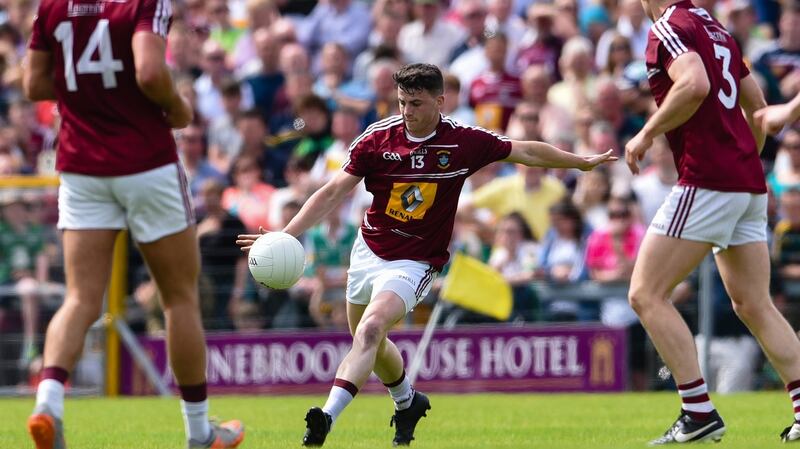In 2015 on these pages, I outlined my idea for an alternative All-Ireland championship, based on national rankings, which I believe would allow all county teams in the country to perform on a fair playing field. It was a modest proposal and in the seasons since, nothing has changed except that the Leinster championship is in ruins and the gap between Dublin and all other teams would appear to be widening at an alarming rate.
Within the context of last weekend's Leinster final, it was a complete performance by Dublin against Meath. We were looking for a chink in the armour or a hangover. None of that is in plain sight. If anything, they look more streamlined and efficient and ruthless in every aspect of play. They work like dogs and are ravenous for the ball. There are very few areas where they don't have absolute control over the game plan. They have refreshed the team with younger players whom Dessie Farrell knows and their bench is, once again, stacked with menace and experience and, lets be frank, brilliance.
And it is self perpetuating. Within the city, the Dublin team has become a cultural force. The jersey is trendy and family friendly and their popularity is huge. If Donegal, post their Ulster final performance are in an uncertain place and Kerry also have questions to answer, then we must ask if there is even a true competition out there right now? Or are we deluding ourselves?
I believe for the first time there is genuine concern in Kerry that their old rivals might be moving out of their reach. That the gap is getting bigger and may be there to stay. Behind Kerry are teams who have known big successes, like Tyrone and Galway and Mayo and Donegal. And they, too, to my mind, can see the writing on the wall.
It is almost incredible, therefore, to think that in 2003 there was a committee established under Seán Kelly’s presidency to ‘rescue’ Dublin football. The idea seems laughable now. The question arises: what did it need rescuing from? It was only eight years since their previous All-Ireland title and they had won three of the previous 10 Leinster titles too. Did it need to be rescued from the spectre of Meath and Offaly and Westmeath winning provincial titles? If so, the mission was a success; 15 out of 16 of the last Leinster championships have gone to Dublin. Was it rescued from its own under achievement or was it from the threat presented by the burgeoning popularity of rugby and soccer?
Many people read the open letter this week from the Westmeath player John Connellan. I hope its substance is under serious consideration from those within the GAA. I think it is poignant because it came from a player and one who has been on the receiving end of this Dublin juggernaut. It forces people to at least sit up and listen and, hopefully to provide an answer – which hasn't been the case up to now.
John is saying that players within Leinster are being robbed of meaningful intercounty careers. That is a very strong statement, to my mind. But look at Leinster and then compare it to the other provinces. Games in Ulster or Connacht are meaningful, whether you win or lose. But Leinster is meaningless because the ultimate outcome has now become inevitable.

So his conclusion is that Leinster football is not only dying, it is already dead: He is calling for equal funding and significant changes, which he doesn't believe will happen. And in that case, he is calling for county boards to boycott the competition. It is a hugely significant stance. The numbers he cites do not lie: Dublin received central funding of €16.6 million from 2007-2017. Not to mention the added €8 million from AIG over the past decade – and other official sponsorship deals. Per registered player the funding to Mayo was €21 and Kerry €19 while in Dublin the figure is €270. That leads to an obvious question: why is a Dublin player valued at a multiple of 13 or 14 to players from other counties?
It has come full circle. The Leinster championship now needs rescuing from Dublin.
I want to make it clear that Dublin have done nothing wrong. Nothing. They have simply got their house in order. All the Dubs see is that they train their socks off, compete hard and win. So it is impossible for them to see the unfairness of this. But the disparity is huge.
It comes down to player development and overall fairness. It doesn't matter whether you are 12 years old today in Westmeath or Dublin: you should have the same opportunity to develop as a footballer. You must have the same exposure to high performance processes. So a high performance national standard must be set by the GAA and then rolled out. There should be a high performance director in each county. Whether it is Dublin or Leitrim, the child should have the exact same experience.
You can't have the areas with the highest populations enjoying all the resources and amenities and funding as well as the pick of kids. It simply won't work. There is a reason why St Mirren aren't favourites to win the Scottish Premiership every year. And why Celtic and Rangers are.
Its because they are the biggest clubs with the most money. John Connellan didn't sit down to pen a letter out of sour grapes. It's because in 15 years time he knows that Dublin will have won 29 out of 30 Leinster titles. And by shining a light on Leinster, you are projecting what will happen on the national stage. Go back to Scotland. Who has won the Premiership outside the big two? No club since Aberdeen 36 years ago- and there is nothing to suggest that is going to change.
It won't be simple or easy to turn this around. This is going to take a radical intervention and we may have to wait five plus years to see any change. Like, the Dublin project is only beginning to function on a streamlined level now. They still have Stephen Cluxton who can remember what it is like to be hammered in Croke Park. One day soon, no Dublin player will know that experience.
It is vital that all counties have access to those same high performance standards for development and that will require serious financial investment by the GAA in ALL other counties. There can’t be a difference. Otherwise the competition is not fair.
In the meantime, the GAA has the power to reimagine its competitions and breathe new life into them – and therefore restore hope within counties. Players, teams and coaches need to feel as if they are working towards something. At the minute, you play the national league as a preparation for the championship. You play the provincial championship and you, in most cases, get knocked out. And fundamentally, that is it. The oxygen is gone and you limp out of the qualifiers.
But it doesn't have to be like that. I firmly believe that the competition structure outlined on these pages can completely revolutionise the championship experience for all counties. Ultimately, it would mean diverging into two All-Ireland competitions: the traditional Sam Maguire competition featuring the top 16 ranked teams and a distinct competition featuring county teams ranked 17 to 32.
I would call these the All-Ireland playoffs and rather than ‘tiers’ which denotes decreasing scales of importance, I would call them ‘brackets’. And the playoffs featuring teams ranked 17-32 must be given the same prominence, with all games taking place before Sam Maguire games. This includes games scheduled for Croke Park and both All-Irelands take place as one national occasion.
Top 16 rankings are based on league placing plus the four provincial championship winners. So you retain the provincial titles – and this winter has proven beyond doubt that it would be crazy to do away with those competitions. But even those counties who are in the lower ranks of the league and get knocked out of their provincial championship get to play in a real competition.
The GAA must insist on serious sponsorship, on televised games and, crucially, in playing those games on the same ticket as Sam Maguire games. In each bracket, team one would play team 16, team two play 15 and so on. And teams could toss for home venue. So you could have a scenario where Dublin, ranked number one, draws maybe a team like Armagh, loses the home toss and has to go to the Athletic Grounds. They may get caught. But so what? Isn't that the beauty of it?
But I have no worries about the Sam Maguire contest. The real importance, if the GAA is serious about making the All-Ireland fair, lies in the promotion and investment of time and purpose in the other bracket. It’s crucial that the county teams who have been also-rans for a century are made to feel as if they matter.
Don’t tell me that counties playing in Croke Park in an All-Ireland final in front of 80,000 people won’t buy into that concept. And if there is a row over tickets: tough. And watch the competitiveness surge. Watch the brilliant games. Watch the standard improve.
Why this doesn’t make common sense to the powers that be is beyond me. Look at Galway, who did really well in the league this year. Under this system, they would earn a high seeding. Equally Cavan were relegated to Division 3 but because they won the Ulster title, they would be back in the Sam Maguire playoff competition.
So it gives teams hope. It connects all competitions and allows the second bracket teams to try and win what would be a real All-Ireland championship- and cement their place in the Sam Maguire bracket the following year.
So rolling out a proper national coaching and strength and conditioning plan is an absolute if this cherished intercounty game is to thrive going forward. But let’s show a bit of boldness and imagination and breathe new life and opportunity into this.
What's seldom is wonderful and one of the reasons why the Tipperary story is so emotive is that they have to go back to 1935 to their last big day in Munster. They shouldn't have to wait as long again for their next. The GAA needs to radically rethink the direction of Gaelic football if they want to be able to look people in the eye and say that it's a game for everyone.















